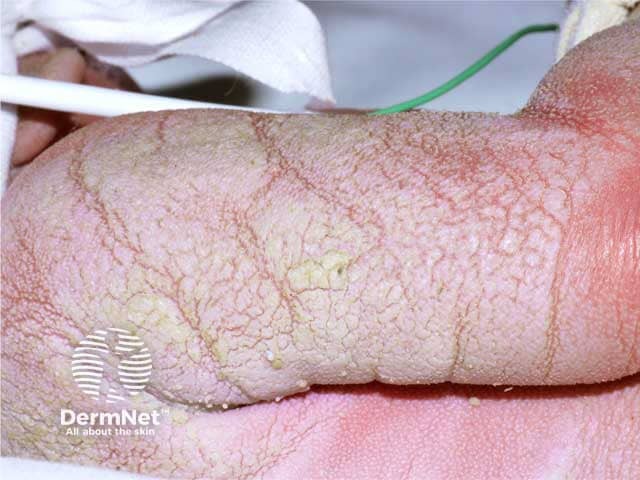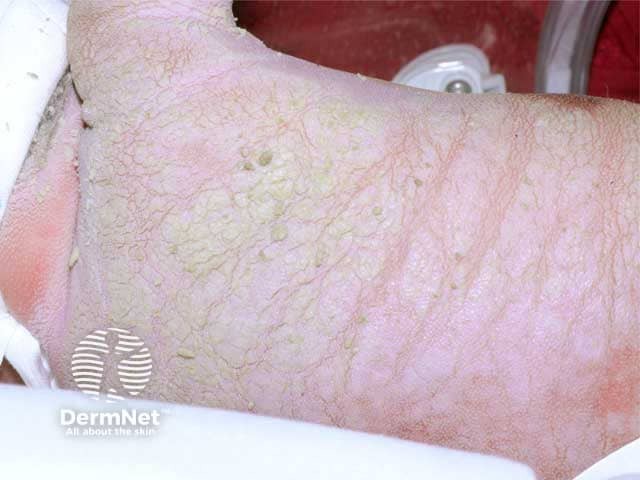Main menu
Common skin conditions

NEWS
Join DermNet PRO
Read more
Quick links
Ichthyosis prematurity syndrome — extra information
Ichthyosis prematurity syndrome
Author: Dr Ian Coulson, East Lancashire NHS Trust, UK. Copy edited by Gus Mitchell. January 2022
Introduction Demographics Causes Clinical features Complications Diagnosis Differential diagnoses Treatment Outcome
What is ichthyosis prematurity syndrome?
Ichthyosis prematurity syndrome is a rare autosomal recessive genetic skin disorder in which affected infants are born prematurely with abnormal skin covered in a thick clay-like vernix.
Their mothers usually develop polyhydramnios, which can precipitate premature labour, and after birth, the affected infant often develops severe, temporary respiratory failure. If the infant survives, the skin may remain red and slightly scaly for the rest of its life.

Ichthyosis prematurity syndrome skin at 48 hrs of life

Ichthyosis prematurity syndrome - thick hyperkeratotic skin over the back at 48 hrs of life
Who gets ichthyosis prematurity syndrome?
Ichthyosis prematurity syndrome is a rare condition with less than 100 affected individuals reported worldwide.
Being recessively inherited, both parents must carry a copy of the defective gene in order for this recessive disorder to manifest. Clusters of cases have been reported from Ireland and Scandinavia.
What causes ichthyosis prematurity syndrome?
Ichthyosis prematurity syndrome is caused by mutations of the SLC27A4 gene that codes for the fatty acid transport protein 4 (FATP4), which is responsible for skin barrier function during the embryonic and neonatal period.
This mutation results in abnormal desquamation of keratinocytes into the amniotic fluid, causing polyhydramnios. Aspiration of the excessive amniotic keratinocyte debris into the lungs results in temporary respiratory failure in the days after delivery.
What are the clinical features of ichthyosis prematurity syndrome?
- Premature birth
- Thick and abnormal clay-like vernix coating. If removed by gentle rubbing, the underlying skin is pink and hyperkeratotic
- Early neonatal respiratory failure is usual
- Neonatal asphyxia
- Peripheral blood eosinophilia is usual
Skin changes lessen rapidly, and during later childhood and adulthood, there may be mild ichthyosis and follicular hyperkeratosis.
What are the complications of ichthyosis prematurity syndrome?
- Respiratory distress in the immediate postpartum period.
- Fluid loss from the skin during the neonatal period.
How is ichthyosis prematurity syndrome diagnosed?
The clinical appearance at birth is characteristic even though it is rare. Specific diagnostic tests include:
- Genetic testing: SLC27A4 gene mutation confirms the diagnosis, replacing the need for neonatal skin biopsy (showing hyperkeratosis and follicular plugging).
- Transmission electron microscopy: presence of perinuclear swelling of keratinocytes and trilamellar lamellae in the horny layer.
- Maternal ultrasound: may show a “starry sky” appearance of the amniotic fluid, facilitating antenatal diagnosis.
- Aspirated amniotic fluid microscopy.
What is the differential diagnosis for ichthyosis prematurity syndrome?
The clinical appearance is unique but other inherited skin conditions may need consideration, such as:
- Bullous ichthyosiform erythroderma
- Non-bullous ichthyosiform erythroderma
- Collodion baby
- Harlequin ichthyosis.
What is the treatment for ichthyosis prematurity syndrome?
General measures
- Vernix can be gently removed with gauze and an emollient.
- Infants should be nursed in a high humidity incubator.
- Emollients and humectants can be used for the ichthyosis remaining after the neonatal period.
- Genetic counselling of the parents is required.
Specific measures
- Low dose dexamethasone has been advocated for respiratory complications.
- Temporary ventilatory support may be required.
What is the outcome for ichthyosis prematurity syndrome?
Subsequent pregnancies require expert obstetric care and ultrasound observation of the amniotic fluid. Affected babies should be delivered with ventilatory support available.
An affected individual may continue to have dry skin and follicular ichthyosis into adult life. There is a higher incidence of atopic conditions (asthma, eczema, and hay fever).
Bibliography
- George R, Santhanam S, Samuel R, et al. Ichthyosis prematurity syndrome caused by a novel missense mutation in FATP4 gene-a case report from India. Clin Case Rep. 2015;4(1):87–9. Published 2015 Dec 1. doi:10.1002/ccr3.462. Journal
- Henderson D, Murphy CA, O'Dea M, Boyle MA. Experience of low-dose dexamethasone use in the respiratory management of ichthyosis prematurity syndrome. BMJ Case Rep. 2021;14(8):e243348. Published 2021 Aug 20. doi:10.1136/bcr-2021-243348. Journal
- Khnykin D, Rønnevig J, Johnsson M, et al. Ichthyosis prematurity syndrome: clinical evaluation of 17 families with a rare disorder of lipid metabolism. J Am Acad Dermatol. 2012;66(4):606–16. doi:10.1016/j.jaad.2011.04.014. Journal
- Lwin SM, Hsu CK, McMillan JR, Mellerio JE, McGrath JA. Ichthyosis Prematurity Syndrome: From Fetus to Adulthood. JAMA Dermatol. 2016;152(9):1055–8. doi:10.1001/jamadermatol.2016.1187. Journal
On DermNet
Other websites
- FIRST (Foundation for Ichthyosis and related Skin Types)
- Ichthyosis Support Group
